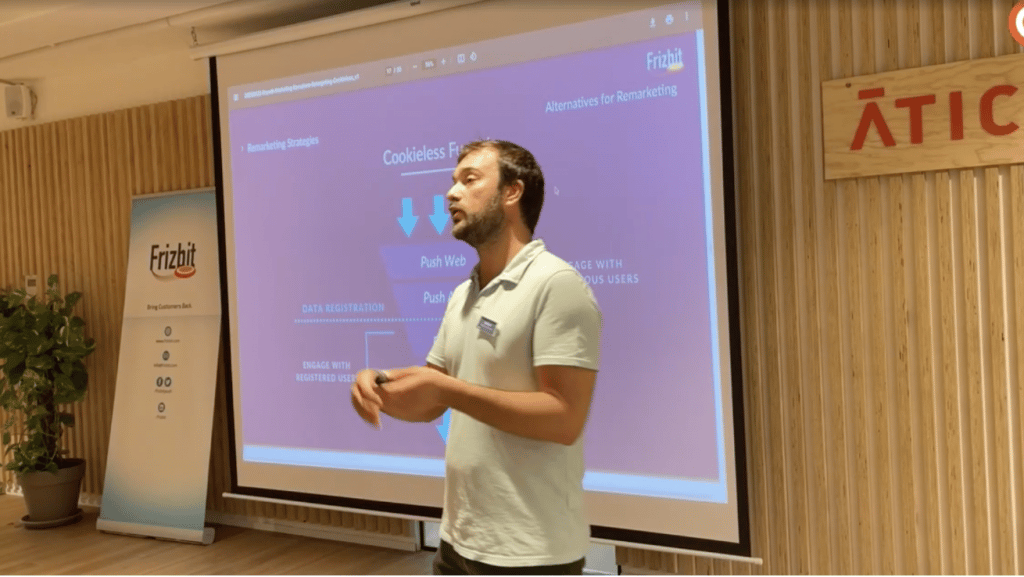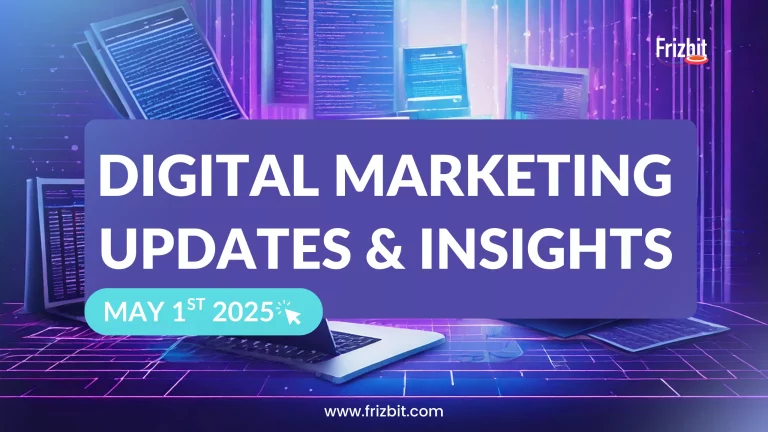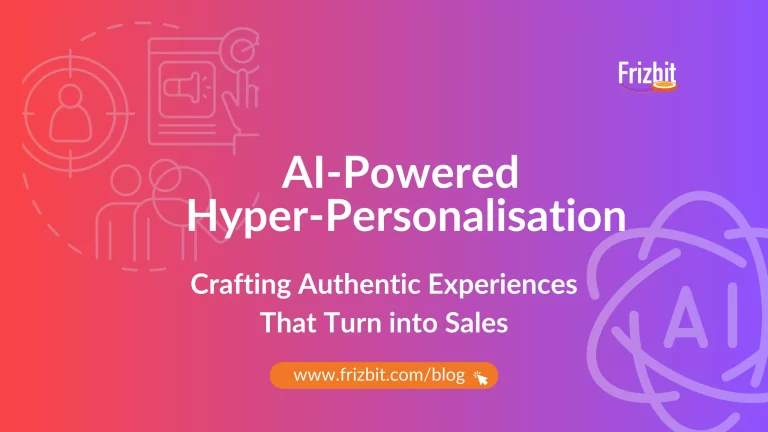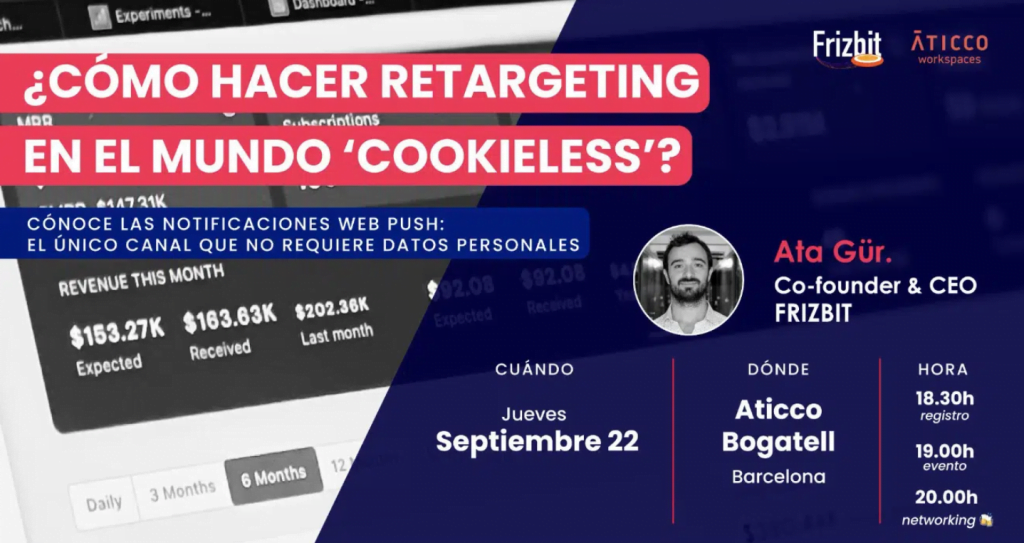
Click here to watch the replay of the session in Spanish
On the 22nd of September, we hosted our first event after the summer break, and we must admit it felt like a great way to come back to the routine. As usual at our events, we enjoyed -which was maybe – the last open terrace networking session of the year with some mandatory beers.
This time, the main topic of the event was the controversial ‘cookieless era’. And our main goal was to equip our attendees with the tools and strategies so that they could stay at the top of their game. Questions such as “Can I actually do retargeting without ads/third-party cookies?”, “What are the cookieless strategies I can implement?”, “What’s the difference between first-party and third-party cookies?” were answered by our host and CEO, Ata Gur.
So, if you couldn’t join us at the event, but still would like to learn more about the main takeaways, keep on reading to elevate your marketing skills.
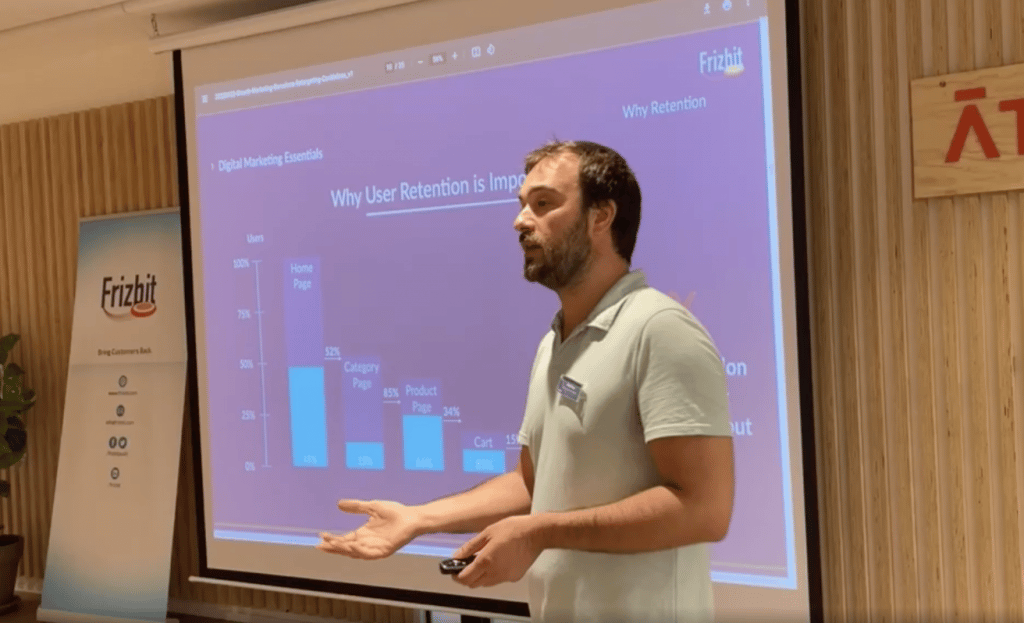
To start off, it is essential to understand the customer journey that a user usually does while navigating a website with a conversion purpose, whether that is a sales or acquiring leads goal.
The usual journey has 5 stages that customers go through until they reach the intended purpose. It starts with a 100% conversion rate and ends up with a 1% conversion rate and an estimated value of $25 USD.
The key takeaway #1 is that client acquisition is indeed an expensive process already, so why not look further into retention to maximise all efforts?
As shown in this graphic, returning customers frequently represent a higher conversion rate than new customers. So, if you have an e-commerce and your sales goals aren’t going as expected, perhaps your focus shouldn’t be on “how to acquire new customers?”, but rather on “how can I better nurture my returning customers?”
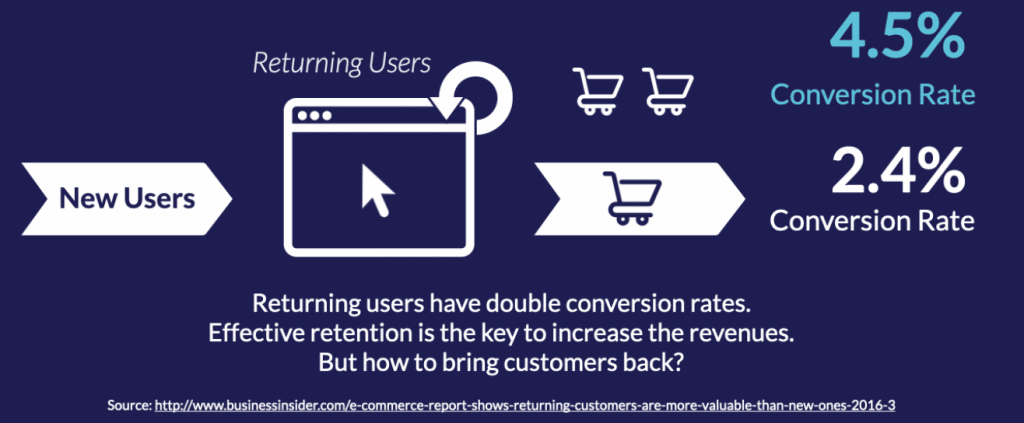
At this point, you have seen why retention is crucial for any eCommerce business. Now, let’s move forward with the alternatives to the retention channels that you have:
- Email, SMS, social media, app push notifications & web push notifications: Belong to the owned media category and work with first-party cookies.
- Retargeting ads: Bring the customers back with third-party cookies, and a pay-per-click basis. The ROI is usually adequate, but the ‘cookieless era’ is their biggest threat. Many browsers are restricting its usage, such as Safari, Firefox and soon Google Chrome. This revolutionizes the way we are used to doing retargeting because every retargeting service provider like Facebook, Google, Criteo or other third-party providers will need to change or else become obsolete.
You might be thinking: “Okay, but I still hear “cookies”, both first and third-party cookies. What’s the difference?”
To keep it short, the main difference is that with third-party cookies, our information can be accessible to all the ads network. Our information is available and shared with others who we don’t trust or know anything about. In fact, 72% of the users reported feeling observed and tracked for their online behaviour, according to Pewresearch.org.
On the other hand, with first-party cookies, we can rest assured that our information will be stored safely, as it is directly anchored to the domain we are at. This means our information isn’t shared with others we aren’t aware of.
Alternatives to third-party cookies for retargeting
Now, let’s dive deeper into what it means that we are moving into a ‘cookieless world’ and what actions you can take to minimise the loss.
The first thing to have in mind is that the cookieless world is nothing more than a new system that is here to stay and is here to protect the privacy of users. As it is an imminent change, there’s no reason to avoid it or delay its implementation.
The key takeaway #2 is that now we need to move forward with understanding and building new cookieless funnels. Our efforts should be focused on first-party cookies channels.
In the following graphic, you can find an example of what a cookieless funnel can look like:
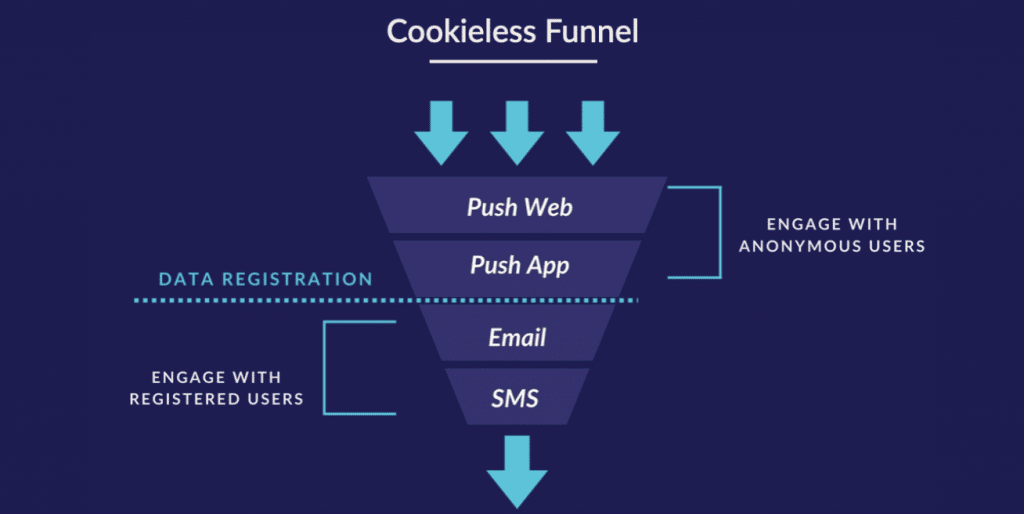
What are the main advantages of relying on first-party cookies, and what channels do you have at your disposal?
- The channels you can use are: push web, push app, email, and SMS
- The main advantage is that you can double your reach by attaining both registered and non-registered users (A.K.A. you don’t need a form to target users with push web and push app notifications)
- You can hyper-personalise the experience, meaning that automatisation doesn’t have to feel cold and robotic.
- You can interact with your audience before they even register with push web and push app notifications, even if they are not on the app or site.
- The interactions can be intentional, meaning you can set them up according to the behaviour of the user.
- Users don’t stay in just one channel: maximise your marketing efforts so that you can target your users across their customer journey.
Key takeaway #3: Maximise your retargeting efforts by relying on first-party cookies channels.
Discover the benefits that Web Push Notifications can bring to your e-site
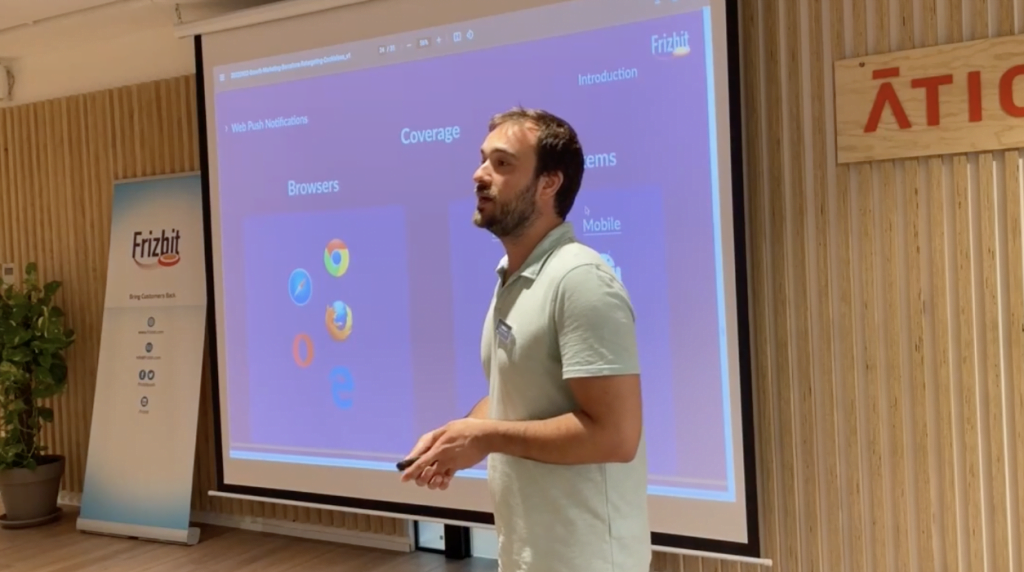
In this case, we are going to revise further our starred channel: Web Push notifications. We found there was an industry gap for this particular channel and have specialised enough, which has led us to know the ins and outs of it.
Web push notifications are the newest retention channels for websites, in which messages are sent by a website and appear on the screen of a user’s device. As we mentioned earlier, messages can be sent even if the website is closed, and they can operate without personal data. It is the latest and a very powerful digital channel for websites to re-engage and communicate with subscribers who opt-in to receive them, providing useful/interesting information.
Where can you use web push notifications or browser push notifications?
The coverage you get by using these notifications is great.
For browsers, they are fully operative on:
- Safari
- Chrome
- FireFox
- Microsoft Edge
- Opera
On the other hand, in operating systems they work on:
- Microsoft Desktop
- MacOS
- Android
- iOS (coming soon with iOS 16 in 2023!)
Key takeaway #4: Web push notifications can bring a higher opt-in rate, increasing your reach and retargeting possibilities. Web push notifications have a 5% to 10% opt-in rate, whereas email opt-in ranks at a 2-4%. With the release of the web push notifications on iOS 16, it means the current rate is likely to increase by 50%.
What are the expected results?
To make it clear, you can find in the following chart how all the different channels can be compared in terms of opt-in rate, click rate and reach rate:
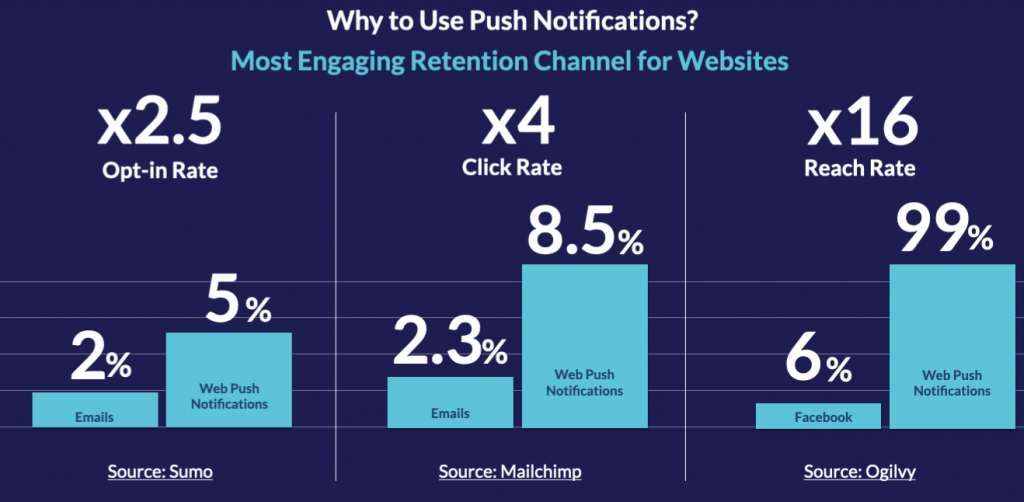
With these graphics, we can see clearly that, on average, web push notifications have better performance rates than other channels, including social media posts.
Emails, on the first hand, require that users confirm their opt-in, which can easily push back the users to complete the action. Social media, on the other hand, usually prioritise paid ads, meaning that organic posts are hardly seen by your audience.
With web push notifications, the opt-in only requires one click from the user. The click rate can be completely personalised and tailored to the part of the customer journey your user is at, making it relevant. Lastly, the reach is definitely one of its strengths as typically you aren’t competing with other brands, opposite to what happens in social media.
Another great advantage of using web push notifications is that they are completely GDPR friendly, as they don’t require the usage of personal data for them to succeed.
How do we use web push notifications at Frizbit?
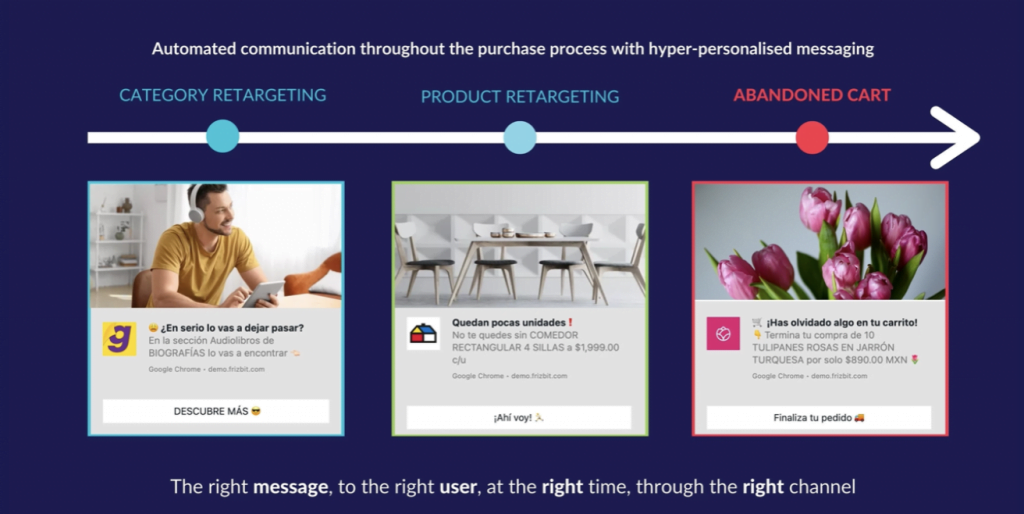
We begin by analysing your sales funnel and creating hyper personalised notifications for each stage of the funnel. For instance, if in an e-commerce a user is interested in the category of the same product, but doesn’t add the product to their cart, they will receive a notification that helps them to go back and purchase a particular product.
Key takeaway #5: Nothing is more relevant than sending the right message, to the right user, at the right time, through the right channel. And web push notifications can help to do this effectively.
If at this point, you are wondering if the web push notifications can be beneficial for your business, you can apply for a free demo here.
First-party cookies retargeting strategies
We want to show you that moving on from third-party cookies is possible. You can do retargeting without relying on them while keeping in line with the newest GDPR regulations.
In the following graphic, you can see what an integral strategy, incorporating different first-party cookies channels, looks like:
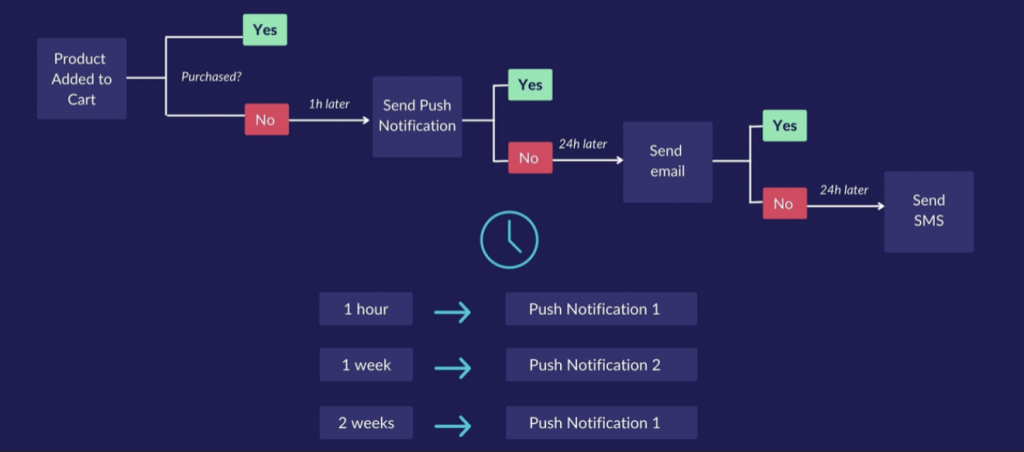 In this example, we are showing a retargeting strategy for abandoned carts. As seen here, you can combine different channels seamlessly, creating personalised flows with specific timing options.
In this example, we are showing a retargeting strategy for abandoned carts. As seen here, you can combine different channels seamlessly, creating personalised flows with specific timing options.
What are the expected results you can look for with each channel?
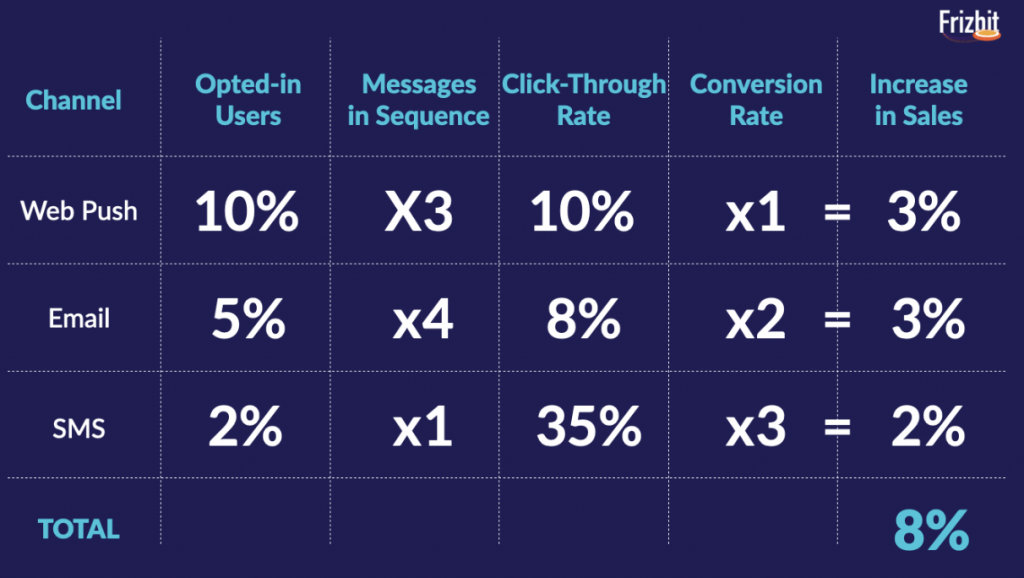
Definitely, using all the channels strategically can represent an increase in sales or in your conversion goals. Each channel has a particular strength, and whether you should use one or another in a higher proportion depends on the purpose and industry of your brand.
To summarise:
- The cookieless world is approaching, and we are leaving behind the so-known third-party cookies, which can limit the way we know on how to do retargeting.
- We recommend investing time and effort in developing strong owned media channels.
- Start creating first-party cookies retargeting funnels using channels like web push notifications, email marketing and SMS
- The key element of success for any retargeting strategy is to send the right message, to the right user, at the right time, through the right channel.
Having said this, we would like to thank everyone who took part in this experience and made it possible. Special thanks to Áticco Working Spaces for their collaboration and continuous support.
If you missed the event and want to have a deeper understanding on how to do retargeting without third-party cookies, the replay of the session is available here.
Also, if you’d like to stay in the loop and attend our future events, make sure to join our Growth Marketing Barcelona Meetup group.
We hope to see you at our next event ?
